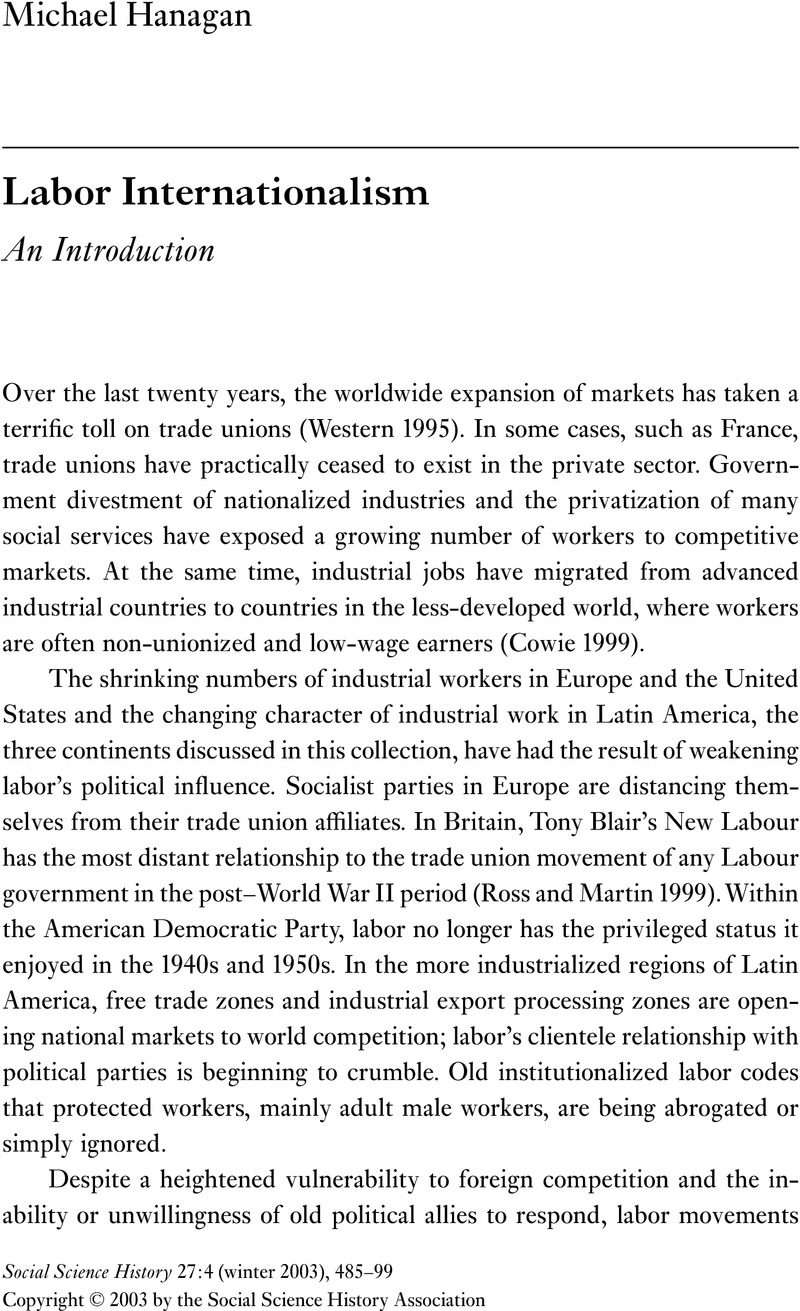No CrossRef data available.
Article contents
Labor Internationalism
An Introduction
Published online by Cambridge University Press: 04 January 2016
Abstract
An abstract is not available for this content so a preview has been provided. Please use the Get access link above for information on how to access this content.

- Type
- Introduction
- Information
- Social Science History , Volume 27 , Issue 4: Special Issue: Labor Internationalism , Winter 2003 , pp. 485 - 499
- Copyright
- Copyright © Social Science History Association 2003
References
Aronowitz, Stanley (1991) The Politics of Identity: Class, Culture, Social Movements.
New York: Routledge.Google Scholar
Ayres, Jeffrey M. (1998) Defying Conventional Wisdom: Political Movements and Popular Contention against North American Free Trade.
Toronto: University of Toronto Press.Google Scholar
Baron, Eva, ed. (1991) Work Engendered: Toward a New History of American Labor.
Ithaca, NY: Cornell University Press.Google Scholar
Brooks, Ethel (2002) “The ideal sweatshop? Gender and transnational protest.” International Labor and Working-Class History
61 (April):91–111.Google Scholar
Burgess, Katrina (2001) “Loosening the reins: The flexibilization of party-union relations in a globalizing world.” Paper presented at the American Political Science Association annual meeting, San Francisco, 28 August-1 September
Google Scholar
Cohen, Lizabeth (1990) Making a New Deal: Industrial Workers in Chicago, 1919-1939.
Cambridge: Cambridge University Press.Google Scholar
Cowie, Jefferson (1999) Capital Moves: RCA’s Seventy-Year Quest for Cheap Labor.
Ithaca, NY: Cornell University Press.Google Scholar
DeMartino, George (1999) “The future of the U.S. labour movement in an era of global economic integration,” in Munck, Ronaldo and Waterman, Peter (eds.) Labour Worldwide in the Era of Globalization: Alternative Union Models in the New World Order.
New York: St Martin’s: 83–96.Google Scholar
Diamond, Stephen F. (1996) “Labor rights in the global economy: A case study of the North American Free Trade Agreement,” in Compa, Lance A. and Diamond, Stephen F. (eds.) Human Rights, Labor Rights, and International Trade.
Philadelphia: University of Pennsylvania Press:199–226.Google Scholar
Fox, Jonathan (1994) “The difficult transition from clientelism to citizenship: Lessons from Mexico.” World Politics
46: 151–84.Google Scholar
French, John D. (2000) “Latin American and international working class history on the brink of the 21st century: Points of departure in comparative labor studies.” Development and Society
29: 137–63.Google Scholar
French, John D., and James, Daniel, eds. (1997) The Gendered Worlds of Latin American Women Workers.
Durham, NC: Duke University Press.Google Scholar
Gereffi, Gary, Korzeniewicz, Miguel, and Korzeniewicz, Robert P. (1994) “Introduction: Global commodity chains,” in Gereffi, Gary and Korzeniewicz, Miguel (eds.) Commodity Chains and Global Capitalism.
Westport, CT: Praeger:1–15
Google Scholar
Gindin, Sam (2001) “Internationalism beyond slogans: Concretizing working class solidarity.” Paper presented to theInternational Research Network on Autowork in the Americas, Hamilton, Ontario, November.
Google Scholar
Hanagan, Michael (1998) “Social movements: Incorporation, disengagement, and opportunities—A long view,” in Giugni, Marco, McAdam, Doug, and Tilly, Charles (eds.) From Contention to Democracy.
Lanham, MD: Rowman and Littlefield:3–30.Google Scholar
Hathaway, Dale (2000) Allies across the Border: Mexico’s “Authentic Labor Front” and Global Solidarity.
Cambridge, MA: South End.Google Scholar
Hopkins, Terence K., and Wallerstein, Immanuel (1986) “Commodity chains in the world-economy prior to 1800.” Review
10: 157–70.Google Scholar
Johns, Rebecca A. (1998) “Bridging the gap between class and space: U.S. worker solidarity with Guatemala.” Economic Geography
74: 252–72.Google Scholar
Keck, Margaret E., and Sikkink, Kathryn (1998) Activists beyond Borders.
Ithaca, NY: Cornell University Press.Google Scholar
Kitschelt, Herbert (1994) The Transformation of European Social Democracy.
Cambridge: Cambridge University Press.Google Scholar
Krasner, Stephen D. (1999) Sovereignty: Organized Hypocrisy.
Princeton, NJ: Princeton University Press.Google Scholar
Kriesi, Hanspeter, Koopmans, Ruud, Dyvendak, Jan Wille, and Giugni, Marco G., eds. (1995) New Social Movements in Western Europe: A Comparative Analysis.
Minneapolis: University of Minnesota Press.Google Scholar
McAdam, Doug, Tarrow, Sidney, and Tilly, Charles (2001) Dynamics of Contention.
Cambridge: Cambridge University Press.Google Scholar
Melucci, Alberto (1989) Nomads of the Present: Social Movements and Individual Needs in Contemporary Society, ed. Keane, John and Mier, Paul. Philadelphia, PA: Temple University Press.Google Scholar
Middlebrook, Kevin J. (1995) The Paradox of Revolution: Labor, the State, and Authoritarianism in Mexico.
Baltimore, MD: Johns Hopkins University Press.Google Scholar
Moody, Kim (1997) Workers in a Lean World: Unions in the International Economy.
New York: Verso.Google Scholar
Munck, Ronaldo, and Waterman, Peter, eds. (1999) Labour Worldwide in the Era of Globalization: Alternative Union Models in the New World Order.
New York: St. Martin’s.Google Scholar
Nelson, Bruce (2001) Divided We Stand: American Workers and the Struggle for Black Equality.
Princeton, NJ: Princeton University Press.Google Scholar
Offe, Claus (1987) “Challenging the boundaries of institutional politics: Social movements since the 1960s,” in Maier, Charles S. (ed.) Changing Boundaries of the Political.
Cambridge: Cambridge University Press.Google Scholar
Piven, Frances Fox (1991) “The decline of labor parties: An overview,” in Piven, Frances Fox (ed.) Labor Parties in Postindustrial Societies.
Oxford, U.K.: Polity:1–19.Google Scholar
Ramsay, Harvie (2000) “Know thine enemy: Understanding multinational corporations as a requirement for strategic international laborism,” in Gordon, Michael E. and Turner, Lowell (eds.)Transnational Cooperation among Labor Unions.
Ithaca, NY: ILR:26–43.Google Scholar
Rogowski, Ronald (1989) Commerce and Coalitions: How Trade Affects Domestic Political Alignments.
Princeton, NJ: Princeton University Press.Google Scholar
Ross, George, and Martin, Andrew (1999) “European unions face the millennium,” in Ross, George and Martin, Andrew (eds.)The Brave New World of European Labor: European Trade Unions and the Millennium.
New York: Berghahn:1–25.Google Scholar
Scharpf, Fritz W. (1987) Crisis and Choice in European Social Democacy.
Ithaca, NY: Cornell University Press.Google Scholar
Schmitter, Philippe C. (1979) “Still the century of corporatism?” in Schmitter, and Lehmbruch, Gerhard (eds.) Trends towards Corporatist Intermediation.
Beverly Hills, CA: Sage:7–52.Google Scholar
Shorter, Edward, and Tilly, Charles (1974) Strikes in France, 1830-1968.
Cambridge: Cambridge University Press.Google Scholar
Smith, Jackie (2002) “Globalizing resistance: The Battle of Seattle and the future of social movements,” in Tilly, Jackie and Johnson, Hank (eds.) Globalization and Resistance: Transnational Dimensions of Social Movements.
Lanham, MD: Rowman and Littlefield: 207–29.Google Scholar
Wendt, Alexander (1999) Social Theory of International Politics.
Cambridge: Cambridge University Press.Google Scholar
Western, Bruce (1995) “A comparative study of working-class disorganization: Union decline in eighteen advanced capitalist countries.” American Sociological Review
60: 179–201.Google Scholar


